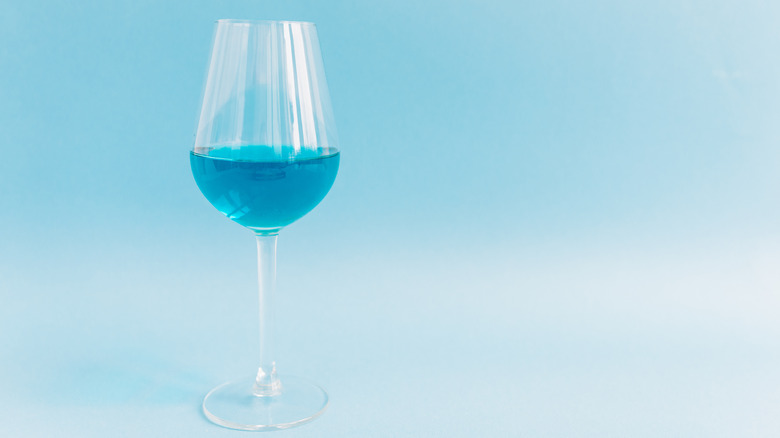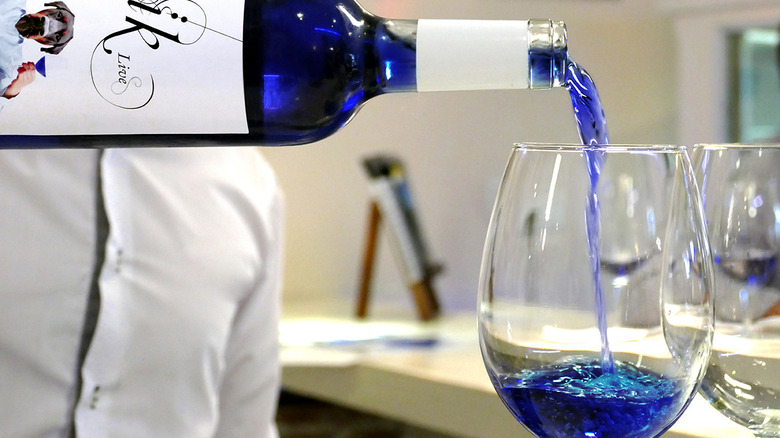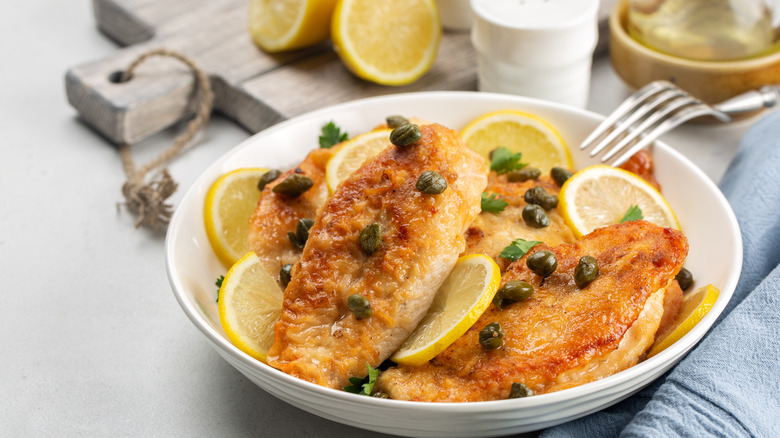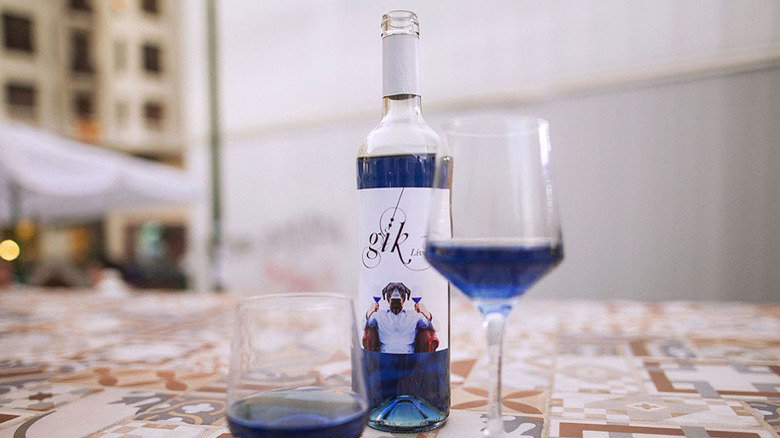What Is Blue Wine And How Does It Get Its Hue?
In the age of the Instagram food aesthetic, pastel colors are everything. From rainbow bagels to Starbucks' infamous blue-and-pink Unicorn Frappuccino to the viral McDonald's Grimace shake, vibrant hues are having a cultural moment. A relatively new trendy drink is a perfect accompaniment — blue wine. First and foremost, yes, blue wine is actually wine — and it's made from a combination of white and red grapes, plus a couple of natural pigments. There are very few foods in nature that are actually blue, but blue wine takes advantage of anthocyanin, the same compound found in blueberries.
Most blue wines on the market today are made from Spanish grapes. The group that invented the product, a Spanish company called Gik, uses fruits from vineyards in La Rioja, Aragon, and Castilla-La Mancha. Other producers use Chardonnay grapes and Merlot skins to achieve the Instagrammable neon-aqua color.
Importantly, this process is different from those of other "colorful" wines. Pink rosé wines are made using red-wine grapes whose contact with the pigmented skins is limited; another trendy drink, orange wine, is made with white wine grapes that are allowed excess skin contact. By contrast, pigmentation in blue wine does come partly from grape skins but is intentionally added, rather than being a natural byproduct of time-honored production methods.
What does blue wine taste like?
Made from a blend of red and white grapes, many trendy Spanish blue wines have a sweet, fruity flavor. Some contain a zero-calorie sweetener; many don't, but all blue wines are typically intended to be served chilled, like dessert wines or ice wine.
As for specific tasting notes, like any wine, it depends on the specific bottle and production run. One variety, called Blú Perfer, lists scents of cherry and raspberry. Another option, Blue Navarra Moscatel, is made using muscat grapes and carries tasting notes of peach and pineapple. The sweetener-added version is reportedly much less delicious. For instance, taste testers at Food and Wine compared it to artificial sugar packets and Kool-Aid.
The inventors of blue wine are all young entrepreneurs from Spain, and the product is intended to have a certain Mediterranean beach flair. Gik, their company, produces a blue wine with an 11.5% ABV, which is on the lower end for many wines and comparable with Portuguese vinho verde, a favorite summer sipper for many beachgoers.
What foods should you pair with blue wine?
Pouring a glass of blue wine for your guests might raise some eyebrows, but finding the right food to serve is key. We do know food color affects how we eat in surprising ways — so when you look past its showy color, blue wine is most similar to sweeter white wines like chardonnay, sauternes, and riesling. To figure out the best food pairings for this trendy beverage, looking to its more reserved cousins is a good place to start.
There are plenty of fish and chicken recipes that pair with white wine, from chicken piccata to poke bowls. Because of blue wine's sweetness, honey-glazed salmon would be a fun choice. The creators of blue wine suggest trying sushi, guacamole, and carbonara pasta.
Because of the sweet fruitiness of blue wine — and its festive hue — it makes for a unique dessert wine, too. Just as when pairing sweet foods with wines like moscato, chocolate and berries would be delicious. If you're going the route of a cheese board, pick sweet and fruity cheeses like mild blue cheeses or creamy goat cheeses with honey.
Where can you buy blue wine?
Today, blue wine is available at many wine stores across Europe, Asia, and the Americas. But that was not always the case, especially in the early days after it was first invented in the late 2010s. Almost immediately, including in its native Spain — where locals are protective over their must-try dishes — the trendy beverage faced regulatory challenges.
Spanish wine regulations prohibit wines that aren't approved colors like red or white, so Gik, the company that invented blue wine, faced fines from the country's Agriculture Ministry. When the drink first arrived in France, it lasted on shelves for three days before officials tried to kick it out.
In response, Gik changed the recipe slightly so it can be enjoyed in Europe — which also helped the product more smoothly cross the pond to the U.S., too. Since its invention, more brands have come onto the market, including a Chardonnay-based blue wine called Blú Perfer. So luckily, no matter what phase you're on of becoming a true wine snob, if you're curious about trendy blue wine, you can probably find it at liquor stores.



